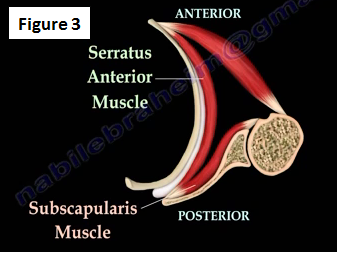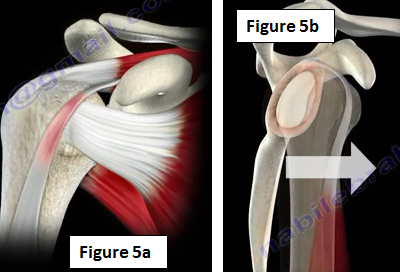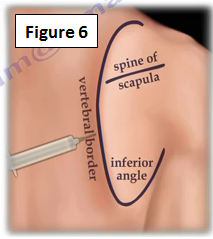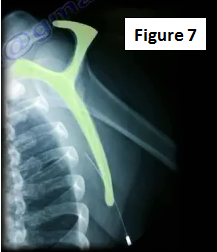What is snapping scapula syndrome?
Snapping scapula syndrome is a condition causing painful grinding, clicking or snapping of the shoulder blade (Figure 1).

The shoulder joint itself is called the glenohumeral joint. The acromioclavicular joint is associated with shoulder separation. Snapping scapula occurs at the scapulothoracic joint and is different from other shoulder related problems (Figure 2). Over 1/3 of the shoulder movement occurs between the scapula and the thoracic cage.

The shoulder blade serves as an anchor for the subscapularis and serratus anterior muscles (Figure 3). These muscles as well as the bursa provide for smooth movement of the shoulder. With muscle weakness or inactivity, the scapula may rub on the rib bones during movement.

Snapping scapula can be caused by repetitive motions that lead to inflammation of the bursa or atrophy of the muscles under the scapula (Figure 4). When the scapula cannot easily glide along the chest wall, the bones rub together and produce the characteristic noise sensation, painful clicking and grinding. It can be a secondary symptom to shoulder instability, such as dislocation or nerve disorders, which may lead to atrophy and weakened muscles. The patient may develop scarring and fibrosis of the bursa, as well as painful scapular crepitus when moving the shoulder blade.

Common Causes
Snapping scapular syndrome may be caused be weakness, wasting or atrophy of the scapular stabilizing muscles, bursitis, osteochondroma, and rib or scapular fractures.
Differential Diagnosis
The "snapping" noise may originate from other areas of the shoulder such as biceps tendon subluxation, labral tear. Biceps tendon subluxation is a condition where the biceps tendon subluxes out of its groove in the humeral head and slips forward causing a "snapping" sensation (Figure 5a). A labral tear is a condition causing pain, often deep in the shoulder, that can be associated with a clicking sound during movement of the shoulder (Figure 5b).

Treatment
Treatment for a snapping scapula includes physiotherapy to improve the stability and coordination of the scapular muscles. An injection of the bursa will also be used. The arm usually is held in a position of extension, internal rotation and adduction with the patient lying prone. The needle should be placed under the scapula and avoid puncturing the pleura (Figure 6). A chest x-ray may be needed after the injection.

A needle inserted into the scapulothoracic joint under fluoroscopy with the aid of scapular "Y" view x-ray. The contour of the scapular projects as the letter Y on the x-ray (Figure 7).

Surgery is rare, and is done for debridement of the bursa or for removal of the bony lump. The debridement is done either open or arthroscopically.
For more information on scapular injuries, follow the links below:
https://www.youtube.com/watch?v=FkPPvroseB4
https://www.youtube.com/watch?v=wTMUqCj5ETg
https://www.youtube.com/watch?v=mYVznO4sBIA
https://www.youtube.com/watch?v=Zw1iD-2Vju8
https://www.youtube.com/watch?v=QMyMIYA9QF0
https://www.youtube.com/watch?v=0R9YsbE6K-o
https://www.youtube.com/watch?v=X6GOcN-DntM
https://www.youtube.com/watch?v=bpkyIHeVesI
https://www.youtube.com/watch?v=O_2MV8C5gR8
https://www.youtube.com/watch?v=NJyuHWIY4wI
https://www.youtube.com/watch?v=0lSarOh4QL4
For more information on other topics, visit my YouTube Channel:
https://www.youtube.com/user/nabilebraheim
-- This feed and its contents are the property of The Huffington Post, and use is subject to our terms. It may be used for personal consumption, but may not be distributed on a website.
No comments:
Post a Comment